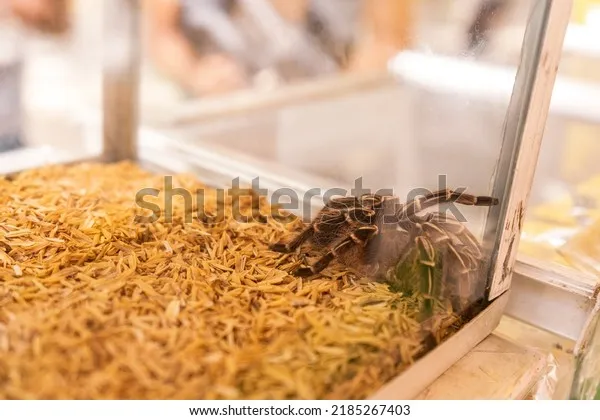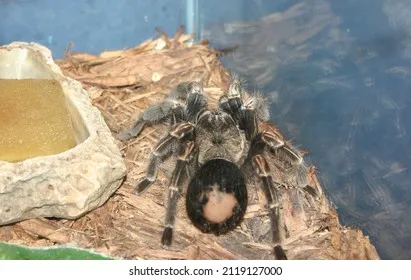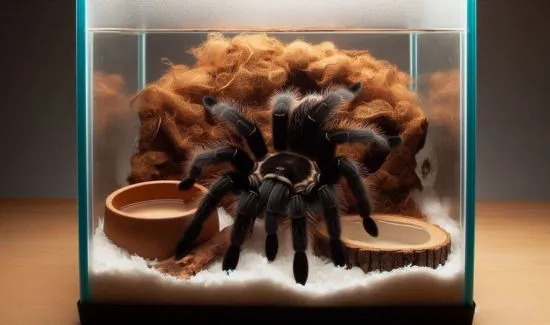Setting up a tarantula tank might seem daunting, but with the right knowledge, you can create a perfect home for your eight-legged friend. This guide will walk you through every aspect of tarantula tank requirements, from choosing the right enclosure to maintaining a healthy environment. A well-designed habitat is crucial for your tarantula’s well-being, ensuring it thrives and lives a long, fulfilling life. This detailed guide will cover everything you need to know to create the perfect tarantula tank setup. Following these guidelines will ensure your tarantula has the best possible environment to thrive.
Choosing the Right Tarantula Tank
The first step in providing a suitable habitat is selecting the right tank. The size, material, and features of the enclosure significantly impact your tarantula’s health and happiness. Consider factors like ventilation, accessibility for maintenance, and aesthetic appeal. Choosing the right tank is not just about providing a place for your tarantula to live; it’s about creating an environment where it can thrive. This section focuses on key aspects to consider when selecting the perfect tarantula tank, ensuring you provide your pet with a secure and comfortable home.
Tank Size Considerations
Tank size is a primary tarantula tank requirement, and it depends on the species and size of your tarantula. A general rule is that the enclosure should be at least twice the tarantula’s leg span in width and length, providing ample space for movement and exploration. Avoid tanks that are too large for smaller tarantulas, as this can make it difficult for them to find food and feel secure. Too large a tank may also increase the risk of falls and injury. The correct tank size is fundamental to a tarantula’s health and happiness, directly affecting its ability to thrive in captivity. A well-sized tank reduces stress and allows natural behaviors like burrowing and foraging.
Tarantula Species and Size

Different tarantula species have varying sizes, directly influencing the required tank dimensions. For instance, a small arboreal species might require a taller tank for climbing, while a terrestrial species needs more floor space. Always research the adult size of your specific tarantula species before purchasing an enclosure. Consider the ultimate size your tarantula will reach to ensure the tank remains suitable as it grows. This foresight prevents the need for frequent tank upgrades, which can stress your pet. Understanding the specific needs of your species ensures their safety and comfort throughout their lifespan.
Ventilation Requirements
Proper ventilation is crucial for tarantula health. It prevents the buildup of harmful humidity, mold, and stagnant air. Tanks should have adequate cross-ventilation, typically achieved through mesh lids or strategically placed air holes. Ensure that ventilation is sufficient but doesn’t compromise the enclosure’s ability to maintain the necessary humidity levels. Poor ventilation can lead to respiratory problems and fungal infections. Look for enclosures with features that promote airflow, such as mesh tops or screened sides. A well-ventilated enclosure also helps to regulate temperature, preventing overheating and ensuring the environment is comfortable for your tarantula. Ventilation is one of the core tarantula tank requirements.
Types of Tanks
Several tank types are available, including glass aquariums, plastic terrariums, and acrylic enclosures. Glass tanks are readily available and offer excellent visibility but can be heavier and may not always provide the best ventilation. Plastic terrariums are lightweight, durable, and often come with built-in ventilation, making them a practical choice. Acrylic enclosures provide superior clarity and can be custom-made to specific sizes. Consider factors like ease of cleaning, durability, and aesthetic appeal when choosing a tank type. The choice often depends on personal preference and the specific needs of your tarantula. Ensure your tank has a secure lid to prevent escapes, as tarantulas are skilled escape artists.
Substrate Selection for Your Tarantula

The substrate is a fundamental element of your tarantula’s habitat, serving multiple purposes: providing a comfortable surface, aiding in burrowing, and helping to maintain humidity levels. The correct substrate also plays a critical role in the overall aesthetic of the enclosure and the well-being of your tarantula. The right substrate choice is essential for creating a natural and enriching environment, supporting their physical and psychological needs. Choosing the right substrate is one of the most critical tarantula tank requirements.
Substrate Types
Several substrate options are available, each with its pros and cons. Popular choices include coconut fiber (coir), peat moss, vermiculite, and a mix of these materials. Coconut fiber is a versatile and absorbent substrate that holds moisture well, making it ideal for humid environments. Peat moss is another excellent option for moisture retention, but it can be dusty and may require careful handling. Vermiculite is useful for retaining moisture and preventing mold. Consider the humidity requirements of your tarantula species when selecting a substrate. Avoid substrates that are toxic or can cause injury, such as gravel or sharp sand. A good substrate replicates the tarantula’s natural environment, encouraging natural behaviors like burrowing and digging. Remember that the substrate is more than just the floor of the enclosure; it is an integral part of your tarantula’s world.
Moisture and Humidity Levels
Maintaining the correct moisture and humidity levels is crucial for tarantula health. Different species have varying requirements. Use a hygrometer to monitor humidity levels accurately. For species that prefer high humidity, regularly mist the enclosure with dechlorinated water and ensure the substrate is damp but not waterlogged. For drier species, provide a shallow water dish and allow the substrate to dry out between mistings. Poor humidity control can lead to dehydration, molting problems, and other health issues. Always research the specific humidity needs of your tarantula species. Proper moisture control is another essential aspect of tarantula tank requirements.
Decorating the Tarantula Enclosure

Decorating the tarantula enclosure is about providing enrichment and a more natural environment. While tarantulas don’t necessarily require elaborate decorations, providing suitable hiding places and climbing structures can greatly benefit their well-being. Ensure all decorations are safe, non-toxic, and won’t trap or harm your tarantula. The setup should meet tarantula tank requirements and be as natural as possible to allow the tarantula to thrive.
Hides and Shelters
Provide at least one hide or shelter for your tarantula. This gives them a secure place to retreat and feel safe, reducing stress. Suitable options include cork bark, half logs, commercially available hides, and even overturned pots. Ensure the hide is appropriately sized for your tarantula and doesn’t have sharp edges. A hide is not just a decorative element; it is a crucial part of your tarantula’s psychological well-being. Hides allow tarantulas to regulate their environment, molt safely, and feel secure within their enclosure. Hides are a core tarantula tank requirement.
Water and Feeding Dishes
A shallow water dish is a must for providing fresh water at all times. The dish should be small enough that your tarantula can easily access it but not so deep that it poses a drowning hazard. Ceramic dishes or shallow plastic lids are suitable options. For feeding, use a small dish or simply drop the food directly into the enclosure. Avoid using dishes that are easily tipped over. Always provide fresh water and remove any uneaten food promptly to prevent mold and mites. Correct feeding dishes are another tarantula tank requirement.
Live or Artificial Plants

Adding plants to the enclosure can enhance its appearance and provide additional hiding places. Live plants can also help maintain humidity levels. However, choose plants that are non-toxic and won’t be easily damaged by your tarantula. Some safe choices include pothos, spider plants, and air plants. If you prefer artificial plants, opt for high-quality, non-toxic varieties. Make sure the plants are securely anchored so they don’t fall and injure your tarantula. Consider how the plants will affect the overall environment and how they will be maintained during cleaning. Including plants can make a big difference in fulfilling tarantula tank requirements.
Heating and Lighting for Tarantulas
Temperature and light are critical environmental factors for tarantulas. While most tarantulas don’t need intense lighting, maintaining the proper temperature range is essential for their health, digestion, and overall activity levels. The ideal environment should mimic their natural habitat as closely as possible, ensuring they thrive. This is one of the core tarantula tank requirements.
Temperature Guidelines
Most tarantulas thrive in temperatures between 75-85°F (24-29°C). Research the specific temperature requirements of your species, as some may need slightly warmer or cooler conditions. Use a digital thermometer to monitor the temperature inside the enclosure accurately. Avoid placing the tank in direct sunlight or near heat sources that could cause temperature fluctuations. Stable temperatures are critical, especially during molting. A thermal gradient, where one part of the enclosure is slightly warmer than another, can be beneficial, allowing your tarantula to choose its preferred temperature. Understanding the optimal temperature range is a crucial tarantula tank requirement.
Heating Options

Several heating options are available. Heat mats, placed on the side or under the tank, are a popular choice. Ensure that the heat mat is controlled by a thermostat to prevent overheating. Ceramic heat emitters are another option, especially for larger enclosures. Incandescent bulbs can also be used, but they may dry out the enclosure and are generally less recommended. Avoid using heat rocks, as they can cause burns. Always monitor the temperature closely and adjust the heating source as needed to maintain the desired temperature range. Proper heating is essential to fulfilling tarantula tank requirements.
Lighting Considerations
Tarantulas are generally nocturnal and do not require intense lighting. Normal room lighting is usually sufficient. Avoid placing the tank in direct sunlight, which can overheat the enclosure. If you choose to use lighting, consider low-wattage LED bulbs for a natural day-night cycle. The light source should not generate significant heat. The primary goal is to provide a natural environment without stressing your tarantula with excessive light. A simple light schedule is often best. Light requirements are part of the tarantula tank requirements.
Maintenance and Cleaning
Regular maintenance and cleaning are essential for keeping your tarantula’s enclosure healthy and hygienic. This includes spot cleaning, removing uneaten food, and occasionally performing a complete tank cleaning. Proper maintenance helps prevent the buildup of harmful bacteria, mold, and mites, ensuring a safe and comfortable environment for your pet. Routine maintenance contributes significantly to tarantula tank requirements.
Spot Cleaning

Spot cleaning should be done regularly, ideally several times a week. This involves removing any visible waste, such as uneaten food, molted exoskeletons, and any other debris. Use tongs or a small scoop to remove waste. Avoid disturbing your tarantula unnecessarily. Regular spot cleaning helps maintain a clean environment, reducing the risk of mold and other issues. Consistent cleaning is a key part of tarantula tank requirements.
Complete Tank Cleaning
A complete tank cleaning should be performed less frequently, typically every few months, or when the substrate is heavily soiled. Remove your tarantula to a temporary holding container. Remove all substrate, decorations, and clean the enclosure thoroughly with warm water and a mild, pet-safe soap. Rinse everything thoroughly to remove any soap residue. Allow the tank and all items to dry completely before reassembling the enclosure. Replace the substrate with fresh material. Complete tank cleaning is a critical part of fulfilling tarantula tank requirements.
Watering Your Tarantula
Provide fresh water in a shallow dish at all times. Refill the water dish as needed, and clean it regularly to prevent algae growth. For species that prefer higher humidity, you may also mist the enclosure. Avoid over-misting, which can lead to excess moisture and mold. Always use dechlorinated water, as chlorine can be harmful to tarantulas. Proper hydration is an essential tarantula tank requirement for ensuring your pet’s health.
Setting up a perfect tarantula tank involves careful consideration of various factors. From choosing the right enclosure size and substrate to maintaining proper humidity and temperature levels, each detail contributes to your tarantula’s well-being. By following these guidelines, you can create a comfortable and stimulating habitat that allows your tarantula to thrive. Remember, consistency and attention to detail are key to successful tarantula care. Now that you know the essentials, you can create a thriving habitat that meets all of the tarantula tank requirements.
